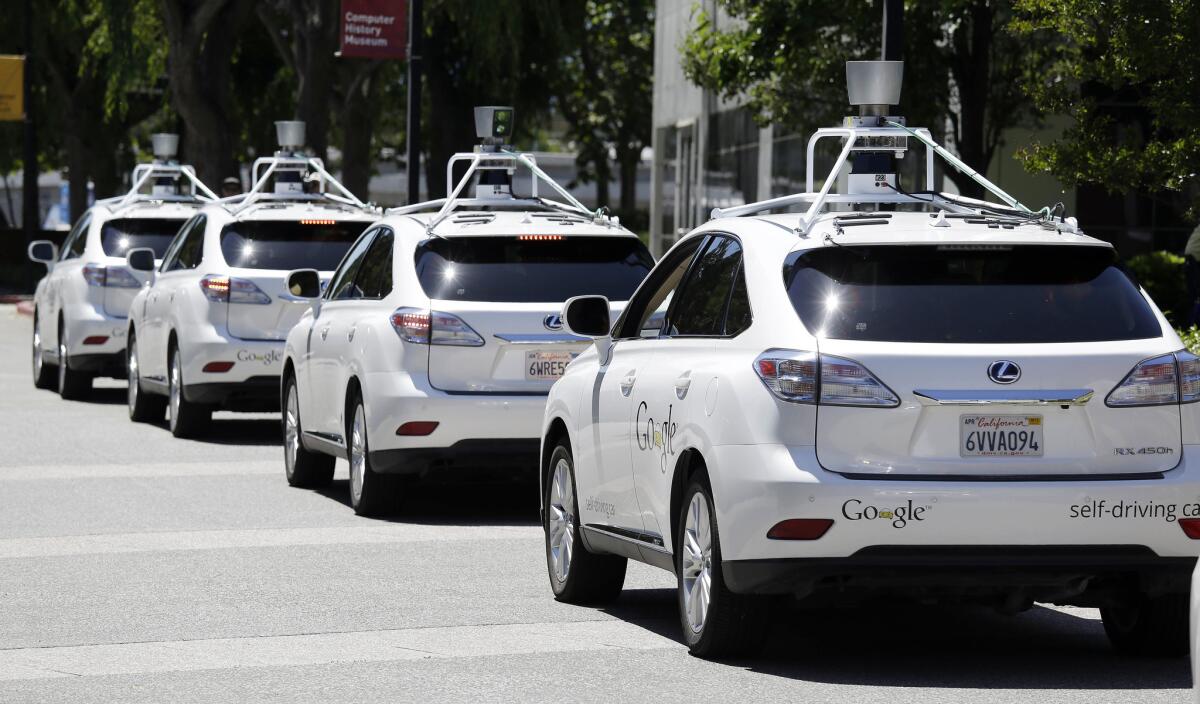Self-driving car prototypes need less human help, data show

- Share via
Self-driving car prototypes appear to be getting better at negotiating California streets and highways without a human backup driver intervening, according to data made public Wednesday by California transportation regulators.
The data reflect safety-related incidents reported by 11 companies that have been testing more than 100 vehicles on public roads, primarily in the Silicon Valley neighborhoods where the technology has grown up. The reports were made to California’s Department of Motor Vehicles, which posted them online.
The documents catalog the number of times from December 2015 through the end of November that humans took over control from a car’s software for safety reasons.
Waymo, as Google’s self-driving car project was recently rebranded, did far more testing than the other 10 companies combined.
Waymo reported that its fleet drove itself more than 635,000 miles with 124 safety-related “disengagements,” which must be reported when the technology fails or the backup driver takes control out of concern the car is malfunctioning.
The Google project’s disengagement rate was the equivalent of two incidents every 10,000 miles, a notable decrease over the prior year, when there were eight disengagements per 10,000 miles.
“This four-fold improvement reflects the significant work we’ve been doing to make our software and hardware more capable and mature,” Dmitri Dolgov, Waymo’s head of self-driving technology,Dmitri Dolgov, Waymo’s head of self-driving technology wrote in a blog post.
Waymo’s chief critic acknowledged the improvement, but John Simpson of the nonprofit Consumer Watchdog said the number of disengagements shows the cars still “simply aren’t ready to be released to roam our roads” without human backup drivers.
Cruise Automation, a startup acquired last year by General Motors, reported driving the second most test miles.
Cruise said that its prototypes had 181 disengagements over 9,776 miles (185 per 10,000 miles) and that it was “pleased with our progress” during testing on the complex streets of San Francisco.
Though imperfect, the data represent the best peek the public gets into the secretive and fiercely competitive world of self-driving cars and how the prototypes are performing.
California required the disengagement reports as part of regulations governing testing on public roads. Separately, the state also requires companies to report any collisions involving its cars.
When the technology will be ready for the public depends on several factors, including regulators’ readiness and company confidence the vehicles are safe.
While Tesla’s Elon Musk has been bullish, talking about months rather than years, companies such as Waymo have suggested 2017 or 2018 is more realistic.
Tesla’s disengagement report said four prototypes drove a total of 550 miles last fall, experiencing 182 disengagements — the equivalent of 3,309 disengagements every 10,000 miles.
Tesla logged the miles primarily to develop a publicly posted video, set to the Rolling Stones song “Paint It Black,” of the driver’s seat perspective in a car where a person does not have to put their hands on the wheel or feet on the pedals. The video promoted how Tesla was shipping cars with advanced sensors that will be activated in the future.
The company already is gathering tens of millions of miles of real-world data when owners engage the current Autopilot feature, which can control steering and speed but is not sophisticated enough to make the cars self-driving from the regulatory perspective.
The Department of Motor Vehicles has been working for several years on regulations that will govern how the technology can be rolled out to the public when companies believe testing shows it is ready.
The state expects to release final “public operation” regulations within six weeks, according to Melissa Figueroa, a spokeswoman for California’s State Transportation Agency.
The Department of Motor Vehicles, which is part of the agency, made public a first draft in December 2015, nearly a year after final rules were supposed to be in place. The department since has revised the language based on developments at the federal level and input from industry and other groups.
The agency and the department declined comment on the reports released Wednesday.
ALSO
An electric car-buying guide, custom-made for L.A.
VW agrees to pay U.S. owners of 3-liter diesels that cheat on emissions tests
GM and Honda team up on hydrogen fuel cell vehicles






